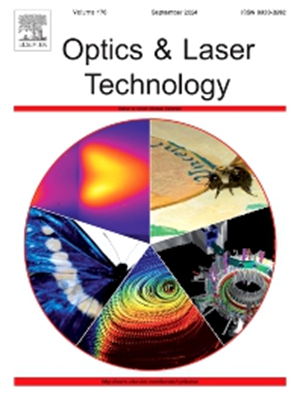Effect of scanning strategy on the thermal behavior, dimensional accuracy, microstructure and hardness of selective laser melting thin-walled structures
IF 5
2区 物理与天体物理
Q1 OPTICS
引用次数: 0
Abstract
Complex thin-walled structures are widely used in engineering, which formation mainly depends on selective laser melting. Understanding the relationship between scanning strategies and forming quality of thin-walled structures is vital for process design. In this paper, the thermal behavior of thin-walled structures under short line scanning strategy (SLSS) and long line scanning strategy (LLSS) was investigated by finite element model, and the dimensional accuracy and microstructure were characterized. The simulation results showed that the SLSS led to intense local heat accumulation, which significantly affects the molten pool morphology and duration. However, the LLSS weakened the local heat accumulation by increasing the time of a single scanning track, resulting in the molten pool size and duration decreasing. Affected by local heat accumulation, the as-built size of LLSS was larger than that of SLSS. With thickness increasing, the dimension error between the two scanning strategies gradually diminished. EBSD maps and SEM figures illustrated that the grain size and cell size produced by SLSS were much larger than that of LLSS. Due the difference in microstructure, the thin walls fabricated by LLSS exhibited higher hardness of 96.62 ∼ 98.72 HV0.5. This study hopefully deepens the understanding of the relationship between scanning strategies and printability of thin-walled structures.
扫描策略对选择性激光熔化薄壁结构热行为、尺寸精度、显微组织和硬度的影响
复杂薄壁结构在工程中应用广泛,其形成主要依赖于激光的选择性熔化。了解扫描策略与薄壁结构成形质量之间的关系对工艺设计至关重要。本文采用有限元模型研究了薄壁结构在短线扫描和长线扫描下的热行为,并对尺寸精度和微观结构进行了表征。模拟结果表明,SLSS导致了强烈的局部热积累,这对熔池形态和持续时间有显著影响。然而,LLSS通过增加单次扫描轨迹的时间来减弱局部热积累,导致熔池大小和持续时间减小。受局部热积累的影响,LLSS的建成尺寸大于SLSS。随着厚度的增加,两种扫描策略之间的尺寸误差逐渐减小。EBSD图和SEM图显示,SLSS产生的晶粒尺寸和细胞尺寸都比LLSS大得多。由于微观结构的差异,LLSS制备的薄壁具有更高的硬度,为96.62 ~ 98.72 HV0.5。本研究有望加深对扫描策略与薄壁结构可打印性之间关系的理解。
本文章由计算机程序翻译,如有差异,请以英文原文为准。
求助全文
约1分钟内获得全文
求助全文
来源期刊
CiteScore
8.50
自引率
10.00%
发文量
1060
审稿时长
3.4 months
期刊介绍:
Optics & Laser Technology aims to provide a vehicle for the publication of a broad range of high quality research and review papers in those fields of scientific and engineering research appertaining to the development and application of the technology of optics and lasers. Papers describing original work in these areas are submitted to rigorous refereeing prior to acceptance for publication.
The scope of Optics & Laser Technology encompasses, but is not restricted to, the following areas:
•development in all types of lasers
•developments in optoelectronic devices and photonics
•developments in new photonics and optical concepts
•developments in conventional optics, optical instruments and components
•techniques of optical metrology, including interferometry and optical fibre sensors
•LIDAR and other non-contact optical measurement techniques, including optical methods in heat and fluid flow
•applications of lasers to materials processing, optical NDT display (including holography) and optical communication
•research and development in the field of laser safety including studies of hazards resulting from the applications of lasers (laser safety, hazards of laser fume)
•developments in optical computing and optical information processing
•developments in new optical materials
•developments in new optical characterization methods and techniques
•developments in quantum optics
•developments in light assisted micro and nanofabrication methods and techniques
•developments in nanophotonics and biophotonics
•developments in imaging processing and systems

 求助内容:
求助内容: 应助结果提醒方式:
应助结果提醒方式:


